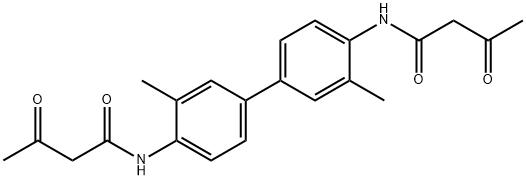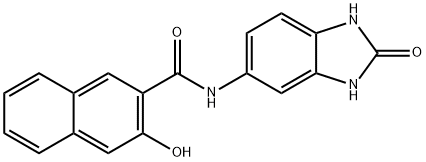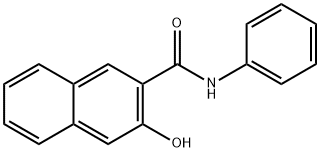N-(4-Ethoxyphenyl)-3-hydroxy-2-naphthamide
- CAS NO.:4711-68-6
- Empirical Formula: C19H17NO3
- Molecular Weight: 307.34
- EINECS: 225-200-7
- SAFETY DATA SHEET (SDS)
- Update Date: 2024-12-18 14:08:52

What is N-(4-Ethoxyphenyl)-3-hydroxy-2-naphthamide?
Preparation
4-Ethoxybenzenamine and 3-Hydroxy-2-naphthoic acid condensation.
Definition
ChEBI: N-(4-ethoxyphenyl)-3-hydroxy-2-naphthalenecarboxamide is a naphthalenecarboxamide.
Properties and Applications
brown powder, melting point for 217 ~ 219 ℃. Insoluble in water and sodium carbonate solution, stable to air. Mainly used for dyeing cotton fabric and glue, also used in the cotton fabric printing. This product to cotton affinity medium, coupled ability medium.
Properties of N-(4-Ethoxyphenyl)-3-hydroxy-2-naphthamide
| Melting point: | 217~219℃ |
| Boiling point: | 519.5℃ at 101.325kPa |
| Density | 1.326g/cm3 at 29℃ |
| vapor pressure | 0-0Pa at 25℃ |
| storage temp. | 2-8°C |
| form | Powder |
| pka | 8.76±0.40(Predicted) |
| CAS DataBase Reference | 4711-68-6(CAS DataBase Reference) |
| EPA Substance Registry System | 2-Naphthalenecarboxamide, N-(4-ethoxyphenyl)-3-hydroxy- (4711-68-6) |
Safety information for N-(4-Ethoxyphenyl)-3-hydroxy-2-naphthamide
Computed Descriptors for N-(4-Ethoxyphenyl)-3-hydroxy-2-naphthamide
New Products
(S)-3-Aminobutanenitrile hydrochloride 4-Methylphenylacetic acid N-Boc-D-alaninol N-BOC-D/L-ALANINOL Tert-butyl bis(2-chloroethyl)carbamate 3-Morpholino-1-(4-nitrophenyl)-5,6-dihydropyridin- 2(1H)-one Furan-2,5-Dicarboxylic Acid Tropic acid 1-Bromo-3,5-Di-Tert-Butylbenzene S-2-CHLORO PROPIONIC ACID ETHYL ISOCYANOACETATE 2-Bromo-1,3-Bis(Dimethylamino)Trimethinium Hexafluorophosphate 4-IODO BENZOIC ACID 3-NITRO-2-METHYL ANILINE 1-(2,4-DICHLOROPHENYL) ETHANAMINE (2-Hydroxyphenyl)acetonitrile 4-Bromopyrazole 2-(Cyanocyclohexyl)acetic acid 4-methoxy-3,5-dinitropyridine 1-(4-(aminomethyl)benzyl)urea hydrochloride 2-aminopropyl benzoate hydrochloride diethyl 2-(2-((tertbutoxycarbonyl)amino) ethyl)malonate tert-butyl 4- (ureidomethyl)benzylcarbamate Ethyl-2-chloro((4-methoxyphenyl)hydrazono)acetateRelated products of tetrahydrofuran








You may like
-
 2033-24-1 98%View Details
2033-24-1 98%View Details
2033-24-1 -
 42831-50-5 5-METHYLISOXAZOLE-4-CARBOXYLIC ACID 98%View Details
42831-50-5 5-METHYLISOXAZOLE-4-CARBOXYLIC ACID 98%View Details
42831-50-5 -
 1975-50-4 98%View Details
1975-50-4 98%View Details
1975-50-4 -
 2-HYDROXY BENZYL ALCOHOL 98%View Details
2-HYDROXY BENZYL ALCOHOL 98%View Details
90-01-7 -
 2-Chloro-1,3-Bis(Dimethylamino)Trimethinium Hexafluorophosphate 221615-75-4 98%View Details
2-Chloro-1,3-Bis(Dimethylamino)Trimethinium Hexafluorophosphate 221615-75-4 98%View Details
221615-75-4 -
 61397-56-6 CIS BROMO BENZOATE 98%View Details
61397-56-6 CIS BROMO BENZOATE 98%View Details
61397-56-6 -
 14714-50-2 (2-Hydroxyphenyl)acetonitrile 98+View Details
14714-50-2 (2-Hydroxyphenyl)acetonitrile 98+View Details
14714-50-2 -
 118753-70-1 98+View Details
118753-70-1 98+View Details
118753-70-1
Statement: All products displayed on this website are only used for non medical purposes such as industrial applications or scientific research, and cannot be used for clinical diagnosis or treatment of humans or animals. They are not medicinal or edible.